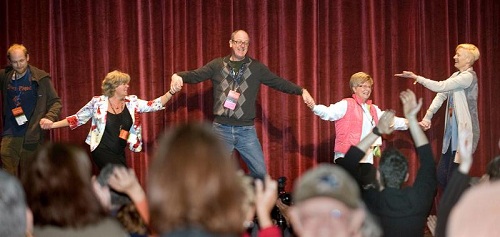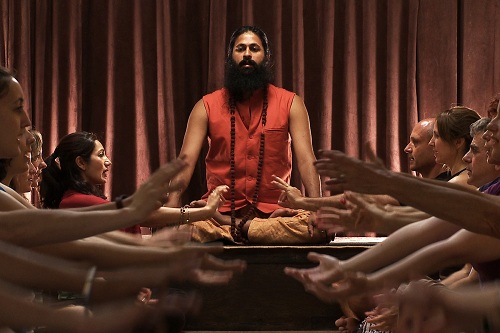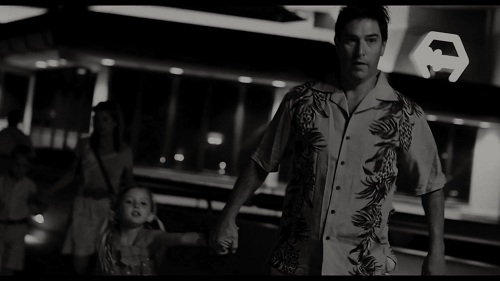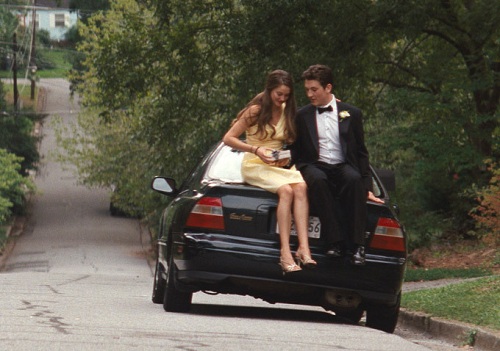After a late day three (the Q&A didn’t get out until about midnight), many of the attendees to Ebertfest, myself included, were a bit on the sluggish side this morning. The first screening was set for 11am, which hardly seems early on paper, but for anyone catching up with friends at the festival or, in my case, writing up articles into the wee hours, 11am came a bit too soon. Honestly, many of us probably were not in a particularly good headspace to approach our first screening of the day, the silent, black and white film Blancanieves.
Fortunately, as can happen at Ebertfest, we were treated to a surprise when, rather than starting with the customary introduction to the first film, Chaz Ebert came on stage and announced that, inspired by Tilda Swinton, we were kicking things off with some dancing in the aisles. Barry White’s “My First, My Last, My Everything” started up, piped through the Virginia’s sound system, and Tilda and Chaz led the dancing, Tilda heading a conga line of jumping and dancing cinephiles and Chaz busting it out in style alone on stage. It was a beautiful, fantastic way to start the day and I had a blast dancing. It woke us up, got our blood moving, and energized us for a day of passionate films. I must report, though, that the balcony didn’t get as into the spirit as I hoped they might. There was plenty of clapping along and smiles, but with Tilda safely downstairs, many were content to watch, rather than participate. Next time, send a VIP or two upstairs to get things going in the balcony! Fortunately by the end of the song, a lot more people had started moving around; they just needed a push to get them started. If any of the PtB at Ebertfest are reading this, by the way, please do as Chaz mused later in the day- please make this a yearly tradition and staple of the festival. We spend at least three solid days sitting together, mostly in silence. Let’s add some interaction, movement, and physicality to the proceedings!
After that lovely beginning, we settled in for Pablo Berger’s 2012 film, Blancanieves. As a silent, black and white, foreign film shot in the style of European cinema from the ‘20s, this is certainly not a film the average viewer would seek out. Fortunately, Roger did the legwork for us, bringing this beautiful, emotionally resonant film to our attention by programming it. While I had trouble with certain elements of the film (bullfighting and the glorification of matadors figure prominently- I’m pretty sure I’m not supposed to be rooting for the bull in those scenes), it is unquestionably a visually stunning and incredibly well-executed film. The performances from the main cast balance the heightened, stylized world of the film with a modern perspective and desire for a subtlety and nuance. The whole cast is great, but perhaps thanks to her perfect introduction, Encarna (Meribel Verdú), the evil stepmother, is who has stayed most strongly in my mind.
Berger and his cinematographer, Kiko de la Rica, work wonders with shadows and flickers of light, saying as much with the staging and lighting of a scene as the performers do with their ever-expressive faces. There’s an abundance of memorable iconography as well- from the hospital-issue scarf holding back Encarna’s hair when we meet her, which perfectly recreates the outline of the villainous Disney queen’s crown, to the enormous staircase and portrait of the house, reminiscent of Rebecca, as well as Beauty and the Beast, fans of cinema and fairy tales in particular will find the frame positively crammed with interesting, meaningful images. The music is also a highlight of the film, well suited to the spectrum of emotions the characters experience.
Despite the title, this is not a straightforward Snow White retelling. Berger mixes in elements from other fairy tales, perhaps most notably Cinderella (our heroine must sleep by the coal and do the household chores), as well as classic films. It also stays true to its darker, original folkloric roots with an intriguing, less-than-happy ending, one that will keep you guessing until the end. Berger introduced his film, using the opportunity to describe just how much Roger and his review of the film meant to him. Afterwards, he returned to the stage to discuss the film and answer questions, with, among others, film historian David Bordwell. Amidst the other production queries posed was one which led to a minor, but entertaining disagreement between Bordwell and Berger about ‘20s cinema and modern audiences’ potential response to the films of that time.
Next was Kumaré, a documentary about a man who transforms himself into a guru in order to examine and expose the cult-like world of yogis. It was a fitting pairing with Blancanieves, though they’re so radically different in setting, tone, and construction. Both examine mythology and the contrast between fairy tale and reality. Both center on lost souls looking for understanding and a way to recover from stress and great loss. Just as Carmencita (the Snow White stand-in) spends much of Blancanieves searching for her absent father, so are Kumaré’s disciples looking for a guide to help them bring order to their world. From its premise, this film could be a simplistic, Borat-like “Gotcha!” prank. Instead, it’s a thoughtful exploration of spirituality, community, and the profound impact one can have on a life by simply sitting down with someone and listening.
Kumaré is also incredibly entertaining, at least as comedic as it is pensive. The gurus shown at the beginning of the film are almost unbelievable, they so clearly and hilariously demonstrate the exploitation possible in a yogi-devotee relationship. But then, as the film unfolds, we watch as Kumaré is put in a position to become another of these manipulative “teachers”. We see how trusting the followers become and how easily these already struggling people could be taken advantage of. One of the many things Kumaré does right is that it never passes judgment on the people seeking guidance. It’s highly critical of the false idolatry of gurus, but never of those looking for help. More than anything, one gets the sense that regardless of the reason for the creation of the Kumaré figure, he really did help these people, and that’s what matters.
After the film, director Vikram Ghandi, who created and portrayed Sri Kumaré, came out with producer Stephen Feder to discuss the film and the process behind it. It was great to hear stories about their experience filming and to find out what certain of the devotees featured in the film are up to now. This had to have been a singular experience for those involved in the production- hopefully there will be some special features depicting or at least discussing it on the eventual DVD. To end the Q&A, at the behest of the final questioner, Ghandi as Kumaré led the room in a brief meditation and Feder led us in the “Ku-maré, ku-maré, kumaaaaa-ré” chant; it was the perfect bookend to both the film and the talk afterwards.
Next up was the much-debated Escape From Tomorrow. Before Ebertfest, it had only been screened at Sundance, so we were one of the first audiences to see this highly anticipated, and incredibly difficult to describe, film. Shot on location at Disneyland, without permission or any involvement from Disney, Escape From Tomorrow is a nesting doll of a film and after seeing it for the first time here, I have almost no clue what happened. It defies traditional genre description and veers sharply left when least expected with absolute glee, but there’s a clear sense that, to some extent at least, there actually are answers. I may not know what they are, but I believe writer/director Randy Moore does and even without understanding the specifics of what actually happens in the film, Escape From Tomorrow has enough interesting things to say about masculinity, aging, fathers and sons, and of course, the mystique and myth of Disneyland that I don’t begrudge it its somewhat oblique plot.
The central figure, Jim (played deftly by Roy Abramsohn), is a family man spending the final day of his family’s trip to Disneyland with his wife Emily and two children, Sara and Elliot. He loses his job over the phone in the opening minutes of the film and his day becomes increasingly troubled and confusing from there. Moore handles the audience with care- what at first appears to be a rather straightforward story of a man trying to spend a day with his family at the Happiest Place on Earth takes an expressionist turn early on before normalizing for quite a while, lulling the viewers back into expectations of a mundane tale. After a while, the film carefully begins heightening its tone until the startling act break, which propels the action to a whole new place. Underneath everything, though, is a strong sense of one man’s experience.
Jim is a strongly realized character and contrasted with the craziness surrounding him is the straightforward approach Moore and Abramsohn take towards him. He spends much of his day ogling a pair of beautiful French girls, for example, more interested in the hilariously phallic imagery around him than the potential weirdness he’s noticed. That’s where this film excels and it’s what’ll keep it from becoming a one-trick movie that loses its allure once the viewer pieces everything together. I can’t wait to see this film again, though to be honest, I rather doubt I’ll get a chance, given the Disney of it all. It was interestingly placed after Blancanieves and Kumaré, which also explore mythology and misplaced, and earned, trust. The Q&A after the film was enlightening, with Moore elaborating on how his childhood trips to Disney with his father inspired the film and editor Soojin Chung and actors Abramsohn, Elena Schuber (Emily), and Annet Mahendru (Isabelle, one of the French girls) discussing the challenge of filming in Disney without being discovered, as well as the identity, gender, and daddy issues on display.
The final film of the day was The Spectacular Now, another hit at this year’s Sundance festival. The story follows Sutter Keely, a popular high school senior who’s a functioning alcoholic. Sutter feels like somewhat of a combination of Ferris Bueller and Lloyd Dobler, but actor Miles Teller makes the character his own, a successor to these memorable teens rather than an imitation. Filling the good girl/savior role is Aimee Finicky, played by Shailene Woodley. Like Teller though, Woodley makes Aimee far more than that tired trope and the biggest strength of the film is the way it handles such a known story with truth and grace. Each of the familiar troubled teen romance beats are approached, but just when you expect it may follow through on them, the film opts instead for simple realism.
The supporting performances are great as well- Brie Larson as Sutter’s popular ex-girlfriend Cassidy, Mary Elizabeth Winstead as Sutter’s sister, Jennifer Jason Leigh as his mom, Kyle Chandler as his dad, and Andre Royo and Bob Odenkirk as other prominent adults in Sutter’s life. Each feels like a fully realized character and it’s great to see teen addiction explored in the mundane world of suburbia. Yes, Sutter has significant abandonment issues thanks to his deadbeat dad, but he’s well-liked and has a substantial support system ready and waiting for him, if he’d only ask for help. There’s little in The Spectacular Now that many won’t have seen before, but rarely is this kind of a story so consistently, beautifully, and truthfully told.
The evening ended with a Q&A with director James Ponsoldt and Shailene Woodley, who discussed filming in Ponsoldt’s hometown and Woodley’s career trajectory, among other topics. It was a full day of cinema and certainly another thought-provoking one. Between the deconstruction of myth and self-exploration present in each film and the daddy issues of Blancanieves, Escape From Tomorrow, and The Spectacular Now, there was plenty to discuss and ponder as we headed home to get some rest before the final day of what’s been a thoroughly enjoyable festival.
Kate Kulzick
Check out the rest of my Ebertfest 2013 coverage:
Day 1- “I Remember” and Days of Heaven
Day 2- “To Music”, Vincent: The Life and Death of Vincent van Gogh, In the Family, Bernie
Day 3- Oslo, August 31st, The Ballad of Narayama, Julia
Day 5– “Sight and Sound Poll: Roger Ebert’s Favorite Films”, Not Yet Begun to Fight
And make sure to check out the video archive for the festival, featuring the introductions to all of the films, the Q&As afterwards, and the panel discussions.






